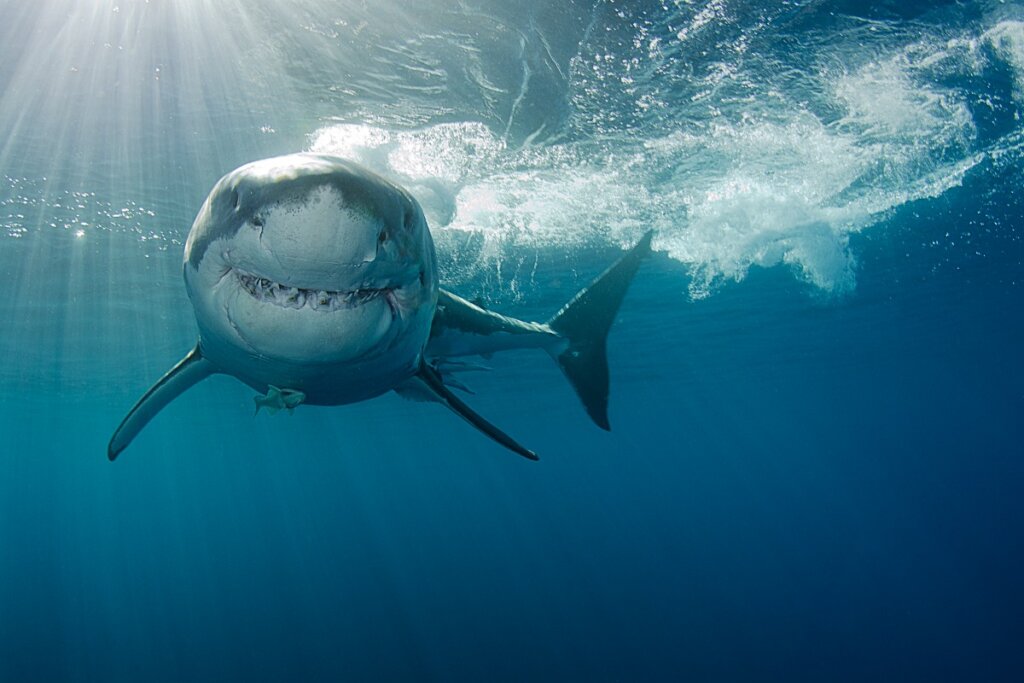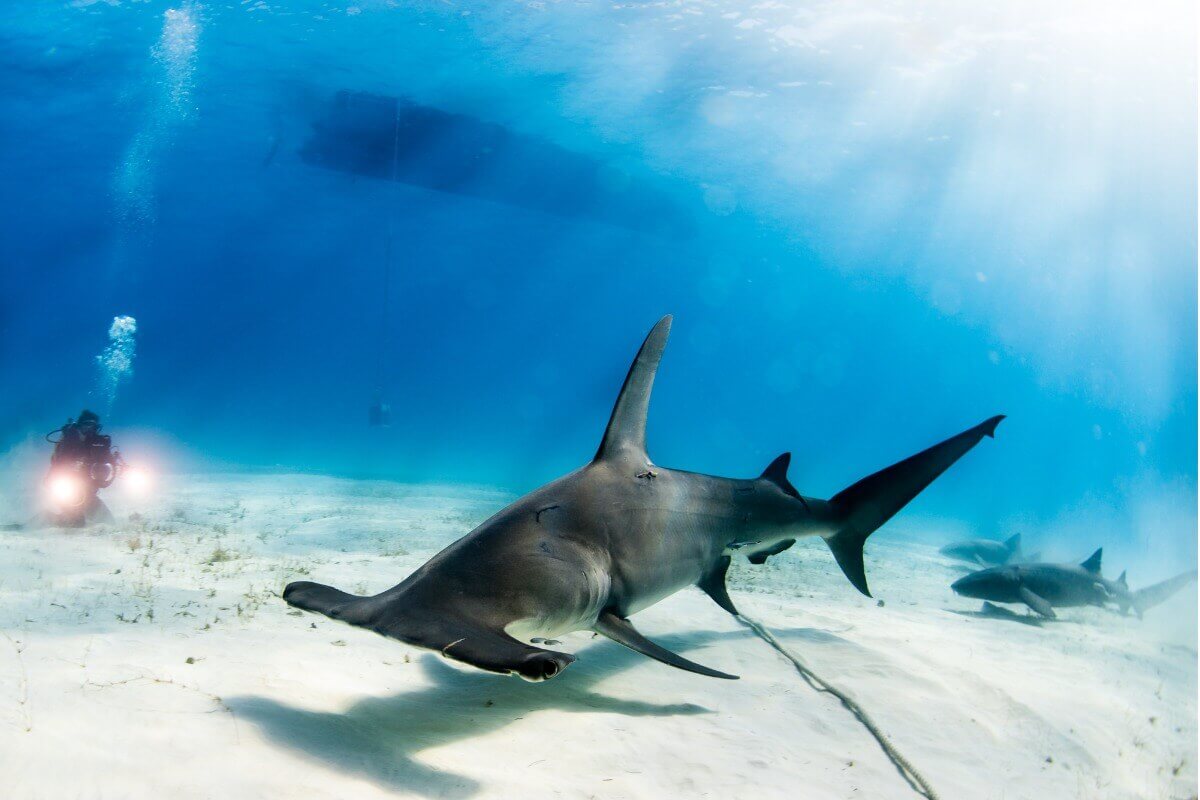How Do Sharks Hunt?

Sharks are the most feared aquatic organisms in the world. Much of this fame is due to their immense size and ferocious jaws. However, these characteristics aren’t the only ones that make them top predators, as sharks hunt their prey thanks to their incredible sensory and anatomical strategies.
These cartilaginous fish have to be ingenious to catch their victims because the effectiveness of the hunt doesn’t depend only on being the strongest organism. These predators must be efficient in order to expend as little energy as possible without sacrificing the amount of food they eat. Keep reading to learn how sharks hunt as well as some of their strategies.
Shark’s tools
In order to understand why these sharks are such efficient predators, you need to take a look at some of their physical characteristics. As you may know, these organisms have gigantic jaws that are protrusible, which means that they can protrude a bit out of their oral cavity. Thanks to this, during the hunt, they can catch their victims if they try to escape.
In addition, sharks’ teeth are complex and can be replaced if they break. Therefore, their mouths have an unlimited number of sharp teeth that can break or become loose, but this doesn’t affect their effectiveness in any way. When confronted with a hard-bodied prey, they can chew on it with the assurance that their jaw won’t be affected.
Although it may not be noticeable, the size of the individuals also gives them a competitive advantage, as this means that not just anyone can attack them. Also, the muscles they develop are so strong that they can swim at high speed. This situation is reinforced by the hydrodynamic shape of their body, which gives them an efficient aspect for an aquatic pursuit.
Sharks need sensory mechanisms that can detect any prey (even at night). For this reason, these organisms have well-developed sensory organs, such as the ampullae of Lorenzini, the lateral line, and their sense of smell. With these extra senses, they’re able to detect smells, movements, and electric fields emitted by the bodies of their prey.

How do sharks hunt?
In general, sharks’ hunting techniques are based on sensing their victims and attacking them by surprise. These organisms have more than one sensory mechanism, so if one is obstructed or damaged, they’re still able to catch their prey. Therefore, the process by which sharks hunt can be divided into 4 specific steps.
- Detection: As a first contact, sharks can receive a distant signal that reveals the prey, either by its smell, its movement, or the noise it makes.
- Search: Once the first clues about the victim are found, the predator begins to follow and look for more evidence of its presence. Some specimens usually swim in circles (or in figures of 8) to try to get indications of their target.
- Location: At this point, the hunters already know the exact location of their prey, so they begin to move carefully towards it. Contrary to popular belief, they stalk slowly, as this prevents their prey from sensing their presence.
- Strike and capture: When the shark is close enough to its victim, it attacks with fast and effective movements to prevent its escape. In some species, it’s normal for them to first immobilize their prey with some kind of blow and then devour them without them resisting.
Although most sharks usually follow the above techniques, some have different ways of capturing their prey. Thus, while some species just open their mouths and suck in their food, others take bites to seriously injure the victim and prevent it from fleeing. Even so, all these capture mechanisms depend on the sensory capacity of the animal’s body.
The body of the shark is important
The adaptations that sharks possess go beyond their senses or behavior, as the shape and color of the body also play an important role. In this sense, the peculiar light coloration on the belly and dark on the back of the sharks are designed so that their victims can’t identify them in the water.
As a result, prey below these animals only see the light belly, which is confused with the light on the surface. On the other hand, if observed from above, only the dark back is visible, which blends in with the ocean floor. This simple difference is a great adaptive advantage for sharks.
Examples of sharks and their strategies
Some species of these cartilaginous fish have different body shapes, which also tends to help them in their hunting. For this reason, larger specimens don’t catch their victims in the same way as smaller ones. Although it’s impossible to list them all, below are some known specimens and the unique strategies of each:
- Hammerhead sharks (genus Sphyrna): These specimens use their heads to hit their prey. In this way, they incapacitate them and end their life in a simple way.
- Whale shark (Rhincodon typus ): The size of these specimens allows them to be not very active when hunting, as they don’t depend on their movement to capture their food. Therefore, to feed, they only have to open their jaws and suck in a large amount of water. In other words, they are filter feeders.
- Lemon shark (Negaprion brevirostris ): This species exhibits a peculiar behavior, as it stirs up the sand to create a “smoke” curtain that allows it to attack its prey without them noticing.
- Great white shark (Carcharodon carcharias ): Although most of these sharks hunt separately, they stay close to each other to attack together if necessary. In this way, they take advantage of shoals of fish or areas with abundant resources.
- Thresher sharks (genus Alopias): The long tail of these sharks is also a tool for hunting, as they’re able to use it as a whip to hit their prey. Moreover, it’s believed that this mechanism is so efficient that they can catch more than one fish at the same time.

Sharks have bodies that are completely adapted to predation, which puts them at the top of the food chain. They have earned their reputation for being dangerous not only because of their appearance but also because of their ability and the methods they have of attacking their prey. It’s true that they are not the most charismatic species, but that doesn’t overshadow their interesting way of conquering the seas.
All cited sources were thoroughly reviewed by our team to ensure their quality, reliability, currency, and validity. The bibliography of this article was considered reliable and of academic or scientific accuracy.
- Martin, R. A., Rossmo, D. K., & Hammerschlag, N. (2009). Hunting patterns and geographic profiling of white shark predation. Journal of Zoology, 279(2), 111-118.
- Garla, R. C., Gadig, O. B., Garcia, J., Veras, L. B., & Garrone-Neto, D. (2017). Hunting tactics of the lemon shark, Negaprion brevirostris, in shallow waters of an oceanic insular area in the western equatorial Atlantic. Neotropical Ichthyology, 15.
- Klimley, A. P., Le Boeuf, B. J., Cantara, K. M., Richert, J. E., Davis, S. F., Van Sommeran, S., & Kelly, J. T. (2001). The hunting strategy of white sharks (Carcharodon carcharias) near a seal colony. Marine Biology, 138(3), 617-636.
- Oliver, S. P., Turner, J. R., Gann, K., Silvosa, M., & D’Urban Jackson, T. (2013). Thresher sharks use tail-slaps as a hunting strategy. PLoS One, 8(7), e67380.
- Gardiner, J. M., Atema, J., Hueter, R. E., & Motta, P. J. (2014). Multisensory integration and behavioral plasticity in sharks from different ecological niches. PLoS One, 9(4), e93036.
